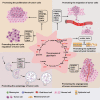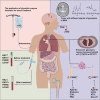The regulatory roles and clinical significance of glycolysis in tumor
- PMID: 38851859
- PMCID: PMC11260772
- DOI: 10.1002/cac2.12549
The regulatory roles and clinical significance of glycolysis in tumor
Abstract
Metabolic reprogramming has been demonstrated to have a significant impact on the biological behaviors of tumor cells, among which glycolysis is an important form. Recent research has revealed that the heightened glycolysis levels, the abnormal expression of glycolytic enzymes, and the accumulation of glycolytic products could regulate the growth, proliferation, invasion, and metastasis of tumor cells and provide a favorable microenvironment for tumor development and progression. Based on the distinctive glycolytic characteristics of tumor cells, novel imaging tests have been developed to evaluate tumor proliferation and metastasis. In addition, glycolytic enzymes have been found to serve as promising biomarkers in tumor, which could provide assistance in the early diagnosis and prognostic assessment of tumor patients. Numerous glycolytic enzymes have been identified as potential therapeutic targets for tumor treatment, and various small molecule inhibitors targeting glycolytic enzymes have been developed to inhibit tumor development and some of them are already applied in the clinic. In this review, we systematically summarized recent advances of the regulatory roles of glycolysis in tumor progression and highlighted the potential clinical significance of glycolytic enzymes and products as novel biomarkers and therapeutic targets in tumor treatment.
Keywords: biomarkers; glycolysis; targeted therapy; tumor development.
© 2024 The Author(s). Cancer Communications published by John Wiley & Sons Australia, Ltd on behalf of Sun Yat‐sen University Cancer Center.
Conflict of interest statement
The authors declare that they have no competing interests.
Figures



Similar articles
-
Functions of Key Enzymes of Glycolytic Metabolism in Tumor Microenvironment.Cell Reprogram. 2023 Jun;25(3):91-98. doi: 10.1089/cell.2023.0010. Epub 2023 May 12. Cell Reprogram. 2023. PMID: 37172278 Review.
-
The dichotomous role of the glycolytic metabolism pathway in cancer metastasis: Interplay with the complex tumor microenvironment and novel therapeutic strategies.Semin Cancer Biol. 2020 Feb;60:238-248. doi: 10.1016/j.semcancer.2019.08.025. Epub 2019 Aug 21. Semin Cancer Biol. 2020. PMID: 31445217 Review.
-
Increased glycolysis correlates with elevated immune activity in tumor immune microenvironment.EBioMedicine. 2019 Apr;42:431-442. doi: 10.1016/j.ebiom.2019.03.068. Epub 2019 Mar 29. EBioMedicine. 2019. PMID: 30935888 Free PMC article.
-
The roles of glycolysis in osteosarcoma.Front Pharmacol. 2022 Aug 17;13:950886. doi: 10.3389/fphar.2022.950886. eCollection 2022. Front Pharmacol. 2022. PMID: 36059961 Free PMC article. Review.
-
Glycolytic genes in cancer cells are more than glucose metabolic regulators.J Mol Med (Berl). 2014 Aug;92(8):837-45. doi: 10.1007/s00109-014-1174-x. Epub 2014 Jun 8. J Mol Med (Berl). 2014. PMID: 24906457 Review.
Cited by
-
Advances in the understanding of the role and mechanism of action of PFKFB3‑mediated glycolysis in liver fibrosis (Review).Int J Mol Med. 2024 Dec;54(6):105. doi: 10.3892/ijmm.2024.5429. Epub 2024 Sep 20. Int J Mol Med. 2024. PMID: 39301662 Free PMC article. Review.
-
Fructose-diphosphate aldolase C as a novel diagnostic biomarker for early-stage non-small cell lung cancer: a low-abundance proteomics study.Transl Lung Cancer Res. 2025 Jun 30;14(6):2239-2256. doi: 10.21037/tlcr-2025-530. Epub 2025 Jun 18. Transl Lung Cancer Res. 2025. PMID: 40673083 Free PMC article.
-
Photo-Thermally Controllable Tumor Metabolic Modulation to Assist T Cell Activation for Boosting Immunotherapy.Int J Nanomedicine. 2024 Nov 3;19:11181-11194. doi: 10.2147/IJN.S483815. eCollection 2024. Int J Nanomedicine. 2024. PMID: 39513087 Free PMC article.
-
Bi-directional metabolic reprogramming between cancer cells and T cells reshapes the anti-tumor immune response.PLoS Biol. 2025 Jul 14;23(7):e3003284. doi: 10.1371/journal.pbio.3003284. eCollection 2025 Jul. PLoS Biol. 2025. PMID: 40658684 Free PMC article.
-
Alterations of metabolites related to microbiota-gut-brain axis in plasma of colon cancer, esophageal cancer, stomach cancer, and lung cancer patients.Open Life Sci. 2025 May 26;20(1):20251115. doi: 10.1515/biol-2025-1115. eCollection 2025. Open Life Sci. 2025. PMID: 40443546 Free PMC article.
References
-
- Li L, Wang M, Ma Q, Ye J, Sun G. Role of glycolysis in the development of atherosclerosis. Am J Physiol Cell Physiol. 2022;323(2):C617‐C29. - PubMed
-
- Chang SM, Vander Heiden MG. Inhibiting GLUTtony in cancer. Cell Chem Biol. 2022;29(3):353‐5. - PubMed
-
- Hsu PP, Sabatini DM. Cancer cell metabolism: Warburg and beyond. Cell. 2008;134(5):703‐7. - PubMed
Publication types
MeSH terms
Substances
Grants and funding
- 82270200/National Natural Science Foundation
- 82070203/National Natural Science Foundation
- 81770210/National Natural Science Foundation
- tspd20230610/Taishan Scholars Program of Shandong Province
- tsqnz20231251/Taishan Scholars Program of Shandong Province
- 2021WWB02/Translational Research Grant of NCRCH
- 2020ZKMB01/Translational Research Grant of NCRCH
- ZR2023QH193/Shandong Provincial Natural Science Foundation
- 2019QL018/Academic Promotion Programme of Shandong First Medical University
- 2018CXGC1213/Key Research and Development Program of Shandong Province
- No. 2023M741506/China Postdoctoral Science Foundation
- Shandong Provincial Engineering Research Center of Lymphoma
LinkOut - more resources
Full Text Sources
Medical

